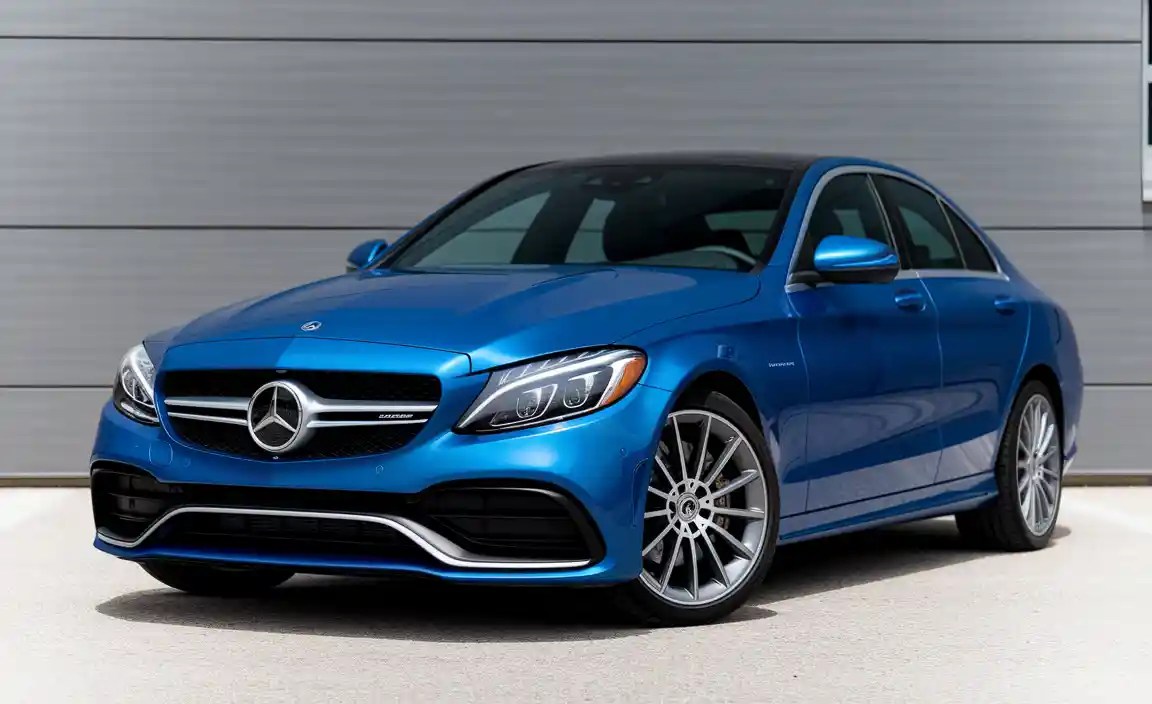Mercedes-Benz C Class Ceramic Coating: Perfect Protection
C Class ceramic coating offers superior, long-lasting protection for your Mercedes-Benz, enhancing gloss and making maintenance a breeze. It forms a hard, transparent layer that shields paint from environmental damage, UV rays, and chemical stains, keeping your C-Class looking showroom-new for years with proper care.
Your Mercedes-Benz C-Class is more than just a car; it’s a statement of style and engineering excellence. Keeping its finish pristine can be a challenge, especially with daily driving exposing it to harsh elements. Swirl marks, water spots, and faded paint can diminish its beauty and value over time.
Many owners find traditional waxes and sealants require frequent reapplication and offer limited protection. If you’re looking for a durable, high-performance solution that truly keeps your C-Class looking its best with less effort, then ceramic coating is the answer you’ve been searching for.
This guide will walk you through everything you need to know about ceramic coatings for your C-Class, from understanding what they are to how they’re applied and why they offer the perfect protection. We’ll demystify the process and show you how a quality ceramic coating can transform and safeguard your beloved Mercedes.

What is C Class Ceramic Coating?
Ceramic coating, also known as a nano-ceramic coating or liquid glass, is a revolutionary protective layer applied to your vehicle’s exterior. Unlike traditional waxes or sealants that sit on top of the paint, a ceramic coating chemically bonds with the factory paint, creating a semi-permanent shield. This shield is incredibly thin, typically measured in microns, yet exceptionally hard and durable.

The primary components of most ceramic coatings are silicon dioxide (SiO2) and titanium dioxide (TiO2), derived from quartz and titanium, respectively. When applied, these elements react with oxygen and moisture in the air, forming a highly durable, hydrophobic, and glossy layer that integrates with your car’s clear coat. Think of it as an extra, invisible layer of clear coat, but one that is far more resistant to chemical etching, UV radiation, and physical abrasion.
The Science Behind the Shine: How Ceramic Coatings Work
The magic of ceramic coating lies in its molecular structure and its reaction with your vehicle’s surface. When the liquid coating is applied, it contains active ingredients that, upon exposure to air, undergo a chemical reaction. This process, often referred to as polymerization, creates a flexible yet incredibly hard glassy layer.
This bonded layer offers several key benefits:
- Hydrophobic Properties: The surface energy of the ceramic coating causes water to bead up and roll off, taking dirt and grime with it. This makes washing your car significantly easier and helps prevent water spots.
- Chemical Resistance: The coating provides a strong barrier against acidic contaminants found in bird droppings, bug splatter, and tree sap, preventing them from etching into your paint.
- UV Protection: It acts as a shield against harmful ultraviolet rays, which can cause paint oxidation and fading over time, especially crucial for luxury vehicles like the C-Class that are often exposed to sun.
- Scratch Resistance: While not entirely scratch-proof, a ceramic coating adds a significant layer of hardness that helps resist minor scratches and swirl marks from light washing or drying.
- Gloss Enhancement: The smooth, uniform surface created by the coating reflects light more evenly, resulting in a deep, glossy finish that makes your C-Class truly stand out.
Ceramic Coating vs. Wax vs. Sealant
Understanding the differences between these protective treatments is key to making an informed decision for your C-Class.
-
- Ease of Application
| Feature | Wax (Natural) | Sealant (Synthetic) | Ceramic Coating (Nano-Ceramic) |
|---|---|---|---|
| Durability | Weeks to a few months | Several months (3-6) | Years (2-5+ depending on type and maintenance) |
| Protection Level | Basic protection against UV and light contaminants | Good protection against UV, light chemicals, and water spots | Excellent resistance to UV, chemicals, etching, light scratches, and extreme temperatures |
| Hydrophobicity | Moderate beading | Good beading | Superior, sheeting water action |
| Very Easy | Easy | Requires meticulous preparation; professional application recommended for best results. DIY kits are available but require care. | |
| Cost | Low | Moderate | High (initial investment) |
| Gloss/Depth | Warm, deep glow | Bright, reflective shine | Extreme gloss, candy-like appearance |
As you can see, while waxes and sealants offer a degree of protection and shine, ceramic coatings provide a significant step up in durability and comprehensive protection, making them an ideal choice for maintaining the pristine condition of a luxury vehicle like your Mercedes-Benz C-Class.
Why Choose Ceramic Coating for Your C Class?
The Mercedes-Benz C-Class is designed to impress, and its paintwork is a crucial element of that aesthetic. A ceramic coating is an investment that pays dividends in maintaining your C-Class’s visual appeal and protecting its value against the relentless assault of the environment.

Preserving the Showroom Finish
Your C-Class deserves the best defense against the elements. From harsh UV rays that fade paint to acidic contaminants like bird droppings and bug splatter that etch into clear coats, your car’s paint is constantly under attack. A ceramic coating acts as a sacrificial, yet incredibly resilient, shield. It hardens the surface and provides a barrier that prevents these damaging substances from reaching your factory paint, keeping it looking like it just rolled off the showroom floor.
Effortless Cleaning and Maintenance
One of the most appreciated benefits of a ceramic coating is its hydrophobic nature. The slick, non-porous surface repels water and dirt. When your C-Class gets dirty, the grime sits on top of the coating, making it far easier to wash off with just soap and water. This means less time scrubbing, less chance of introducing swirl marks during washing, and a car that stays cleaner for longer. For a busy C-Class owner, this can be a significant time-saver.
Enhanced Gloss and Depth
Beyond protection, ceramic coatings significantly boost your C-Class’s aesthetic appeal. The smooth, level surface created by the coating reflects light more uniformly, resulting in an incredible depth of gloss. Your car’s paint will appear richer, deeper, and more vibrant, giving it that sought-after “wet look” that truly amplifies its already luxurious presence. It’s a look that even the finest car detailing can achieve, but with far greater longevity.
Long-Term Value Protection
Investing in a ceramic coating for your C-Class is an investment in its long-term value. By preventing paint degradation, oxidation, and etching, you are preserving the original condition of the paintwork. This is a major factor when it comes time to trade in or sell your vehicle, as buyers are always willing to pay more for a car that has been meticulously cared for and shows minimal signs of wear.
Protection Against Environmental Hazards
Think about what your C-Class encounters daily:
- Sun’s UV Rays: Can cause fading, chalking, and oxidation.
- Acid Rain and Industrial Fallout: Corrosive substances that etch paint.
- Bird Droppings and Bug Splatter: Highly acidic and can quickly etch clear coats.
- Road Salt and Chemicals: Especially in winter, these are corrosive.
- Tree Sap and Tar: Sticky substances that are difficult to remove and can damage paint.
A ceramic coating provides a robust defense against all these common threats, safeguarding the investment you’ve made in your Mercedes-Benz.
Applying a C Class Ceramic Coating: The Process
Applying a ceramic coating is a meticulous process that requires patience and attention to detail. It’s crucial for achieving the best results and ensuring the coating bonds properly to your C-Class’s paint. While professional application is highly recommended for luxury vehicles, understanding the steps involved can help you appreciate the value and skill required.

Step 1: Thorough Wash and Decontamination
Before any coating can be applied, the vehicle must be impeccably clean. This is not just a standard wash; it’s a deep clean to remove all surface contaminants.
- Initial Wash: A thorough two-bucket wash method with a high-quality car shampoo is essential to remove loose dirt and grime.
- Decontamination (Chemical): A pH-neutral iron remover is sprayed onto the paintwork. This product chemically reacts with and dissolves embedded iron particles, such as those from brake dust, turning them purple as they break down. After dwelling, the car is rinsed thoroughly.
- Decontamination (Mechanical): A clay bar or clay mitt is used to gently lift any remaining bonded contaminants (like tar, tree sap residue, or industrial fallout) that the chemical decontamination couldn’t remove. This leaves the paint surface perfectly smooth.
Step 2: Paint Correction (Polishing)
This is arguably the most critical step for achieving a flawless finish. Swirl marks, light scratches, and oxidation must be removed before the coating is applied, as the coating will lock in the existing imperfections.
- Inspection: The paint is inspected under bright lighting to identify all defects.
- Polishing: Using a dual-action (DA) polisher and appropriate polishing compounds and pads, the paint is carefully worked to remove imperfections. This process levels the clear coat, restoring clarity and depth. The specific compounds and pads used will depend on the severity of the paint defects. For a Mercedes-Benz, using high-quality products is paramount to avoid damaging the paint further.
- IPA Wipe-Down: After polishing, the paint surface is wiped down with an Isopropyl Alcohol (IPA) solution (typically a 15-20% dilution with distilled water) or a dedicated panel wipe product. This removes any polishing oils or residue left behind by the compounds, ensuring the ceramic coating can bond directly to the clear coat.
For external resources, you can check out the U.S. General Services Administration’s guide on vehicle paint care for broader automotive maintenance advice.
Step 3: Ceramic Coating Application
With the paint perfectly prepped, it’s time to apply the ceramic coating.
- Environment: Application should be done in a clean, temperature-controlled environment (typically between 50-80°F or 10-27°C) with low humidity to ensure proper curing. Direct sunlight and wind should be avoided.
- Application: The liquid ceramic coating is applied in small sections using a suede applicator block. The amount applied should be minimal and spread evenly. Work in straight lines, then cross-hatch in the opposite direction.
- Leveling/Buffing: After a short flash time (usually 30 seconds to a few minutes, depending on the product and ambient conditions), the coating is gently buffed off with a high-quality microfiber towel. A second, clean microfiber towel is often used to remove any high spots or streaks.
- Curing: The coating needs time to cure. The initial “flash cure” happens quickly, but a full chemical cure can take anywhere from 12 to 72 hours, during which the vehicle should be kept dry and out of direct sunlight and extreme temperatures. It’s recommended to avoid washing the vehicle for at least 7-14 days after application to allow the coating to fully harden and reach its maximum durability.
Step 4: Optional Top Coat (Spay Sealant)
Some professional installers opt to apply a thin layer of a ceramic “spray sealant” or booster after the initial ceramic coating has cured for 24 hours. This can enhance gloss, add an extra layer of hydrophobic protection, and provide a sacrificial layer for the primary coating.
DIY vs. Professional C Class Ceramic Coating
The decision to apply your C-Class’s ceramic coating yourself or to enlist a professional detailer involves weighing cost, time, and the desired outcome.
DIY Ceramic Coating:
Pros:
- Significantly lower cost compared to professional installation.
- The satisfaction of doing it yourself.
- Flexibility in scheduling your application.
Cons:
- Requires significant time, patience, and skill.
- Mistakes can be costly (requiring paint correction to fix).
- Finding a suitable, dust-free environment can be challenging.
- DIY kits may not offer the same longevity or performance as professional-grade products.
If you choose the DIY route, meticulous preparation of the paintwork is paramount. Products like Meguiar’s Detailing Compounds or Adam’s Polishes Ultra-Gloss Wash and Detail Spray can be helpful for the preparation stages.
Professional Ceramic Coating:
Pros:
- Expert preparation and application by trained professionals.
- Access to higher-grade, more durable coatings.
- Guarantees and warranties are often provided.
- Achieves the best possible finish with minimal risk of errors.
- Professionals have the right tools, lighting, and sterile environment.
Cons:
- Significantly higher cost.
- Requires scheduling appointments.
For a Mercedes-Benz C-Class, where perfection is often the expectation, professional application is generally the most recommended route. It ensures that the advanced paintwork of your vehicle is treated with the highest level of care and expertise, maximizing the benefits of the ceramic coating.
Maintaining Your C Class Ceramic Coating
Once your C-Class is protected with a ceramic coating, ongoing maintenance is significantly simplified, but not eliminated. Proper care will ensure the coating performs optimally and lasts for its intended lifespan.

What to Do:
- Regular Washing: Wash your C-Class regularly (every 1-2 weeks) using a pH-neutral car wash soap and the two-bucket method to avoid scratching.
- Use a High-Quality Car Shampoo: Avoid abrasive or high-pH detergents that can degrade the coating over time.
- Dry Carefully: After washing, dry your C-Class with clean, high-quality microfiber drying towels. A leaf blower can also be effective for clearing water from crevices.
- Use Ceramic Boosters (Optional): Periodically (every few months or after washes), you can apply a ceramic spray sealant or detailer. These products refresh the hydrophobic properties of the coating and add a thin protective layer, enhancing gloss and ease of future washing. Look for boosters specifically designed to work with existing ceramic coatings. Brands like Griot’s Garage offer excellent options.
- Address Contaminants Promptly: While ceramic coatings protect against them, it’s still best practice to remove stubborn contaminants like bird droppings or bug splatter as soon as possible. A quick detailer spray and microfiber towel will usually do the trick.
What to Avoid:
- Automatic Car Washes: Many automatic car washes use harsh brushes and chemicals that can scratch and degrade the ceramic coating. Opt for touchless washes if you must use an automatic service, but hand washing is always best.
- Abrasive Cleaners/Polishes: Do not use abrasive compounds or polishes on a ceramic-coated surface unless you intend to remove or repair the coating.
- Harsh Chemicals: Avoid using degreasers or strong all-purpose cleaners on the paintwork, as they can weaken the coating’s integrity over time.
- Scraping or Pressure Washing Too Close: While durable, avoid direct, high-pressure water streams extremely close to the surface or using abrasive brushes to scrub – this can potentially damage the coating or its edges.
A well-maintained ceramic coating on your C-Class will ensure it remains a head-turner for years to come, requiring less effort than you might expect.
Frequently Asked Questions
Q1: How long does a ceramic coating last on a Mercedes-Benz C-Class?
A1: A professionally applied, high-quality ceramic coating can last anywhere from 2 to 5 years, or even longer, with proper maintenance. DIY coatings might offer shorter lifespans, typically 1-3 years. The specific lifespan depends on the product used, environmental exposure, and how well the coating is maintained.
Q2: Is a ceramic coating really worth the cost for a C-Class?
A2: For many C-Class owners, the cost is well worth it. It provides superior protection against environmental damage, significantly reduces the effort required for washing and maintenance, and helps preserve the vehicle’s aesthetic appeal and resale value. It’s an investment in protecting your luxury vehicle.






